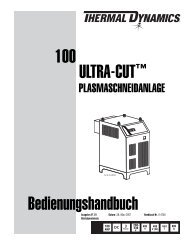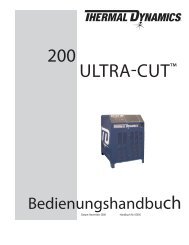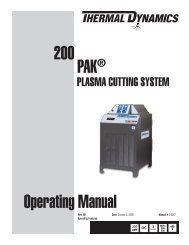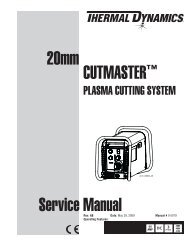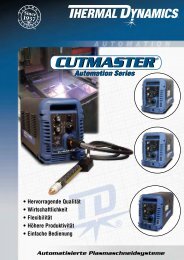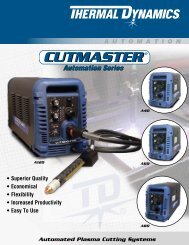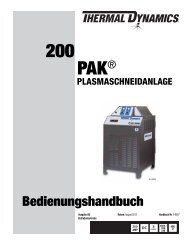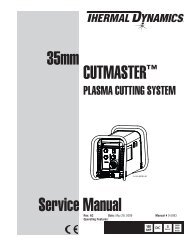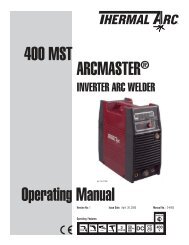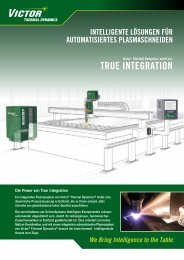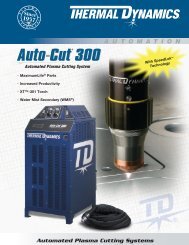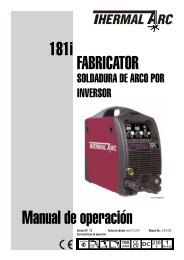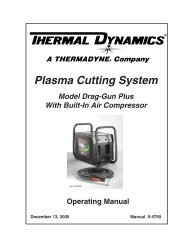211i Operating Manual FabricatOr® - Victor Technologies - Europe
211i Operating Manual FabricatOr® - Victor Technologies - Europe
211i Operating Manual FabricatOr® - Victor Technologies - Europe
Create successful ePaper yourself
Turn your PDF publications into a flip-book with our unique Google optimized e-Paper software.
INSTALLATION/SETUP FABRICATOR <strong>211i</strong><br />
2. Thermal Overload Indicator (Fault Indicator)<br />
This welding power source is protected by a self resetting thermostat. The indicator will illuminate if the duty<br />
cycle of the power source has been exceeded. Should the thermal overload indicator illuminate the output<br />
of the power source will be disabled. Once the power source cools down this light will go OFF and the over<br />
temperature condition will automatically reset. Note that the mains power switch should remain in the on<br />
position such that the fan continues to operate thus allowing the unit to cool sufficiently. Do not switch the<br />
unit off should a thermal overload condition be present.<br />
3. Digital Amps Meter (Left Digital Display)<br />
MIG Mode<br />
This digital meter is used to display the pre-set (preview) Wirefeed Speed in Meters Per Minute (MPM) in<br />
MIG mode and actual welding amperage of the power source when welding. At times of non-welding, the<br />
digital meter will display a pre-set (preview) value of Wirefeed Speed. This value can be adjusted by varying<br />
the Amperage Control Knob (4).<br />
STICK and LIFT TIG Modes<br />
The digital meter is used to display the pre-set (preview) amperage in STICK / LIFT TIG modes and actual<br />
welding amperage of the power source when welding. At times of non-welding, the amperage meter will<br />
display a pre-set (preview) value in both STICK and LIFT TIG modes. This value can be adjusted by varying<br />
the Amperage Control Knob (4).<br />
When welding, this digital meter will display actual welding amperage in all modes.<br />
At the completion of welding, the digital meter will hold the last recorded amperage value for a period of<br />
approximately 10 seconds in all modes. The amperage meter will hold the value until; (1) any of the front<br />
panel controls are adjusted in which case the unit will revert to preview mode, (2) welding is recommenced,<br />
in which case actual welding amperage will be displayed, or (3) a period of 10 seconds elapses following the<br />
completion of welding in which case the unit will return to preview mode.<br />
NOTE<br />
The preview functionality provided on this power source is intended to act as a guide only. Some differences<br />
may be observed between preview values and actual welding values due to factors including<br />
the mode of welding, differences in consumables/gas mixtures, individual welding techniques and the<br />
transfer mode of the welding arc (ie dip versus spray transfer). Where exact settings are required (in<br />
the case of procedural work), it is recommended that alternate measurement methods be utilized to<br />
ensure output values are accurate.<br />
4. Amperage Control (Wirespeed)<br />
The amperage control knob adjusts the amount of welding current delivered by the power source. In STICK<br />
(MMA) and LIFT TIG (GTAW) modes, the amperage control knob directly adjusts the power inverter to deliver<br />
the desired level of output current. In MIG (GMAW/FCAW) mode, the amperage knob adjusts the speed of<br />
the wire feed motor (which in turn adjusts the output current by varying the amount of MIG wire delivered<br />
to the welding arc). The optimum wire speed required will dependent on the type of welding application. The<br />
setup chart on the inside of the wire feed compartment door provides a brief summary of the required output<br />
settings for a basic range of MIG welding applications.<br />
NOTE<br />
The preview functionality provided on this power source is intended to act as a guide only. Some differences<br />
may be observed between preview values and actual welding values due to factors including<br />
the mode of welding, differences in consumables/gas mixtures, individual welding techniques and the<br />
transfer mode of the welding arc (ie dip versus spray transfer). Where exact settings are required (in<br />
the case of procedural work), it is recommended that alternate measurement methods be utilized to<br />
ensure output values are accurate.<br />
<strong>Manual</strong> 0-5225 3-5 INSTALLATION/SETUP



